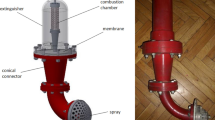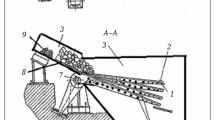Summary of Conclusions
-
1.
When air-pressure abrasive blasting is conducted in enclosed devices (barrels, tables, cabinets and automatic rooms) employing sand as the abrasive the air of the workroom generally contains a highly hazardous dust concentration. The dust itself contains an average of over 90 per cent of quartz and the average dust count of the room atmosphere averages over 20 million particles per cubic foot. Such an atmosphere cannot fail to predispose in a high degree to silicosis.
-
2.
When steel instead of sand is used in such devices as the abrasive material, the dust counts average from 8 to 15 million particles and the quartz content falls to 3 per cent. Such conditions as this should not cause silicosis with any reasonable period of exposure.
-
3.
Even with the use of sand abrasive, our studies show that all the four types of equipment studies can be made safe by proper construction and maintenance. We were able to observe the operation of barrels, tables and cabinets which the designers had previously indicated as of ideal modern design. In all cases the dust content of the air in the neighborhood of these devices averaged less than 2 million particles.
-
4.
In rooms, where the worker must operate in the actual midst of the sand blast, the dust content is, of course, enormous, varying from 48.8 million with steel abrasive, to 327.2 million particles per cubic foot (average 155.0 million); and, with sand abrasive, from 232.0 million to 3,104.0 million particles per cubic foot (average 969.0 million).
-
5.
Helmets depending on filtration are quite inadequate to protect the worker against such dust concentrations; and positive air-pressure helmets with wire mesh eye-screens are irregular and unreliable in their effect.
-
6.
On the other hand, positive air-pressure helmets with glass eye-shields and an air supply of6 cubic feet per minute furnish complete protection to the worker under the worst conditions found in actual operation, yielding a dust content of less than 1 million particles per cubic foot within the helmet, with 1,000.0 million or more particles per cubic foot in the outside air and rising only to 3 million particles per cubic foot within the helmet even when the outside air contains 4,000.0 million particles.
Similar content being viewed by others
List of references
Willis, H. S., Pneumoconiosis and Tuberculosis. Medicine1930.
Russell, A. N., R. H. Britten, L. R. Thompson, andJ. J. Bloomfield, The Health of Workers Engaged in Dusty Trades. II. Exposure to Siliceous Dust (Granite Industry). Publ. Health Bull.1929, Nr 187.
General Report of the Miners' Phthisis Prevention Committee, Union of South Africa, Johannesburg, 15. III. 1916. Appendix Nr 8, Pretoria.
, Extract from the Report of the Director-General of Public Health, New South Wales1927, Section I.-E, Serial Nr 12, 96.
Greenburg, L., andG. W. Smith, A New Instrument for Sampling Aerial Dust. Reports of Investigations Nr2392, Bureau of Mines (1922).
Comparative Tests of Instruments for Determining Atmospheric Dusts. Publ. Health Bull.1925, Nr 144.
Greenburg, L., andJ. J. Bloomfield, The Impinger Dust Sampling Apparatus as Used by the United States Public Health Service. Publ. Health Rep.1932, Mar.
Owens, J. S., Jet Dust Counting Apparatus. J. ind. Hyg.1923, 522.
Hatch, Theodore, andSarah P. Choate, Statistical Description of the Particle Size Properties of Non-uniform Particulate Substances. Reprinted from the Journal of the Franklin Institute.1929.
Winslow, C.-E. A., Greenburg, Leonard andE. H. Reeves, The Efficiency of Certain Devices Used for the Protection of Sand Blasters Against the Dust Hazard. Publ. Health Rep.1920, Nr 35.
Author information
Authors and Affiliations
Additional information
Dr.Teleky zum 60. Geburtstag gewidmet.
Rights and permissions
About this article
Cite this article
Greenburg, L., Winslow, C.E.A. The dust hazard in air-pressure abrasive blasting (sandblasting). Arch. Gewerbepath. 3, 577–599 (1932). https://doi.org/10.1007/BF02125122
Received:
Issue Date:
DOI: https://doi.org/10.1007/BF02125122




